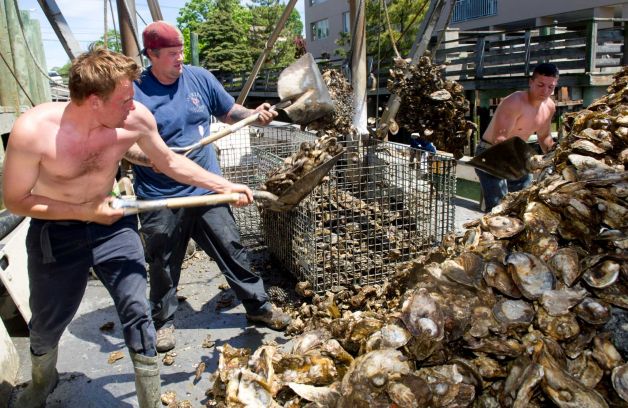In early March 2015, a few enthusiasts responded to a summit invitation by North Carolina’s Coastal Federation so as to create a strategy on how to restore, in a sustainable manner, North Carolina’s oysters. Amongst the participants were oyster enthusiasts, fishermen and scientists. What brought these people together was the need to revitalize the natural bounty of oysters at North Carolina in order to bolster the state’s economy.
Oyster landing data from the late 1880s reflects nature’s bounty in the form of oysters in these coastal waters. This trend even continued upto the beginning of the 20th century wherein oysters were a lucrative trade with almost a million harvested every year. However, from 1902 onwards, their population started to decline. The causes were many but were primarily narrowed down to degradation of habitat, overharvesting and introduction of non-native disease organism.
The declining trend of the oysters had dropped so steeply that currently their harvest levels are just 10% of their historic high.
In order to reverse this trend, for the past 20 years, North Carolina has been actively involved in convening activities that educate and guide the population on means to revitalize the oyster economy. Many millions of dollars have been spent on repairing and researching their habitat, so that oysters can be protected and cultivated in a sustainable manner. However, not much has come off, from all of these efforts. Although citizens of North Carolina like to slurp down oysters, their respect and appreciation for the oysters and its habitat have yet to catch on.
Researchers from the UNC-Chapel Hill Institute of Marine Sciences have had recent breakthroughs which might persuade the stakeholders of North Carolina to have a change of heart towards the humble oyster. The researchers have come up with a model which attach economic values to “ecosystem services” provided by the oysters; this also includes in economic terms the value of the reef that they create which is their natural habitat.
Their model shows in annual acreage the value of the reef if oysters inhabit it. The value of this reef habitat increases dramatically if valuable species of fisheries, such as blue crab and red drum crab ($1,669), are found living in it. The model has another process wherein the economic value of the reef is arrived at by the function it provides to waterfront properties and the stabilizing affect it has on shorelines.
A third process promotes the growth of sea grass meadows by clarifying estuarine waters vide filteration and calculates its economic value thereof. Since sea grass acts as a natural home for shrimps, bay scallops and valuable fisheries they typically add $523. The fourth process in the model first sets a baseline of the pollution level in the bay then adds economic value if nitrogen levels are reduced in the estuaries ($1640).
With the help of these processes, researchers are hoping this economic model will help the populace better appreciate the value of the ecosystem. As per their initial estimates it can be as much as $4,180 per acre.
References:
http://www.newsobserver.com/opinion/op-ed/article16942778.html
Oyster landing data from the late 1880s reflects nature’s bounty in the form of oysters in these coastal waters. This trend even continued upto the beginning of the 20th century wherein oysters were a lucrative trade with almost a million harvested every year. However, from 1902 onwards, their population started to decline. The causes were many but were primarily narrowed down to degradation of habitat, overharvesting and introduction of non-native disease organism.
The declining trend of the oysters had dropped so steeply that currently their harvest levels are just 10% of their historic high.
In order to reverse this trend, for the past 20 years, North Carolina has been actively involved in convening activities that educate and guide the population on means to revitalize the oyster economy. Many millions of dollars have been spent on repairing and researching their habitat, so that oysters can be protected and cultivated in a sustainable manner. However, not much has come off, from all of these efforts. Although citizens of North Carolina like to slurp down oysters, their respect and appreciation for the oysters and its habitat have yet to catch on.
Researchers from the UNC-Chapel Hill Institute of Marine Sciences have had recent breakthroughs which might persuade the stakeholders of North Carolina to have a change of heart towards the humble oyster. The researchers have come up with a model which attach economic values to “ecosystem services” provided by the oysters; this also includes in economic terms the value of the reef that they create which is their natural habitat.
Their model shows in annual acreage the value of the reef if oysters inhabit it. The value of this reef habitat increases dramatically if valuable species of fisheries, such as blue crab and red drum crab ($1,669), are found living in it. The model has another process wherein the economic value of the reef is arrived at by the function it provides to waterfront properties and the stabilizing affect it has on shorelines.
A third process promotes the growth of sea grass meadows by clarifying estuarine waters vide filteration and calculates its economic value thereof. Since sea grass acts as a natural home for shrimps, bay scallops and valuable fisheries they typically add $523. The fourth process in the model first sets a baseline of the pollution level in the bay then adds economic value if nitrogen levels are reduced in the estuaries ($1640).
With the help of these processes, researchers are hoping this economic model will help the populace better appreciate the value of the ecosystem. As per their initial estimates it can be as much as $4,180 per acre.
References:
http://www.newsobserver.com/opinion/op-ed/article16942778.html





